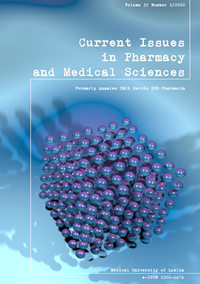The role of appetite-controlling hormones in the development of eating disorders in diabetic 2 patients
DOI:
https://doi.org/10.2478/cipms-2022-0016Keywords:
eating disorders, binge eating, night eating syndrome, diabetes type 2, obesity, leptin, ghrelinAbstract
Binge eating disorder (BED) and night eating syndrome (NES) are common eating disorders (EDs) in individuals with diabetes type 2 (DT2). They worsen metabolic control, have a negative impact on physical and mental health and reduce quality of life. The roles of appetite-controlling hormones – leptin and ghrelin – is not clear enough in EDs and need to be investigated in order to establish new approaches and markers of EDs. Aim: To assess the difference in leptin and ghrelin levels in DT2 patients with and without EDs.
57 patients with DT2 were involved in the study. After physical examination and screening for EDs, blood samples for leptin and ghrelin measuring were obtained.
Results. 19 participants (33.3%) were screened positively for ED (BE or NES). Leptin levels were higher in participants with ED (p<0.05). Conversely, ghrelin levels were lower in those with BE or NES (p<0.05).
Leptin level is increased in DT2 individuals with BED and NES, whereas ghrelin is decreased. Leptin and ghrelin alterations maintain emotional eating, increase the frequency of binge and night eating episodes. In screening for EDs, assessing leptin and ghrelin levels will facilitate obesity reduction and improve metabolic control in diabetic patients.
References
1. Arroyo-Johnson C, Mincey KD. Obesity epidemiology worldwide. Gastroenterol Clin North Am. 2016;45(4):571-9.
2. Harris SR, Carrillo M, Fujioka K. Binge-eating disorder and Type 2 diabetes: A review. Endocr Pract. 2021;27(2):158-64.
3. Allison KC, Crow SJ, Reeves RR, Smith West D, Foreyt JP, DiLillo VG, et al. Binge eating disorder and night eating syndrome in adults with type 2 diabetes. Obesity (Silver Spring). 2007;15(5):1287-93.
4. Urbanovych AM, Laniush FV. The role of ghrelin and serotonin in the control of eating behavior in patients with obesity and diabetes mellitus type 2. Int J Endocrinol. 2020;16(2):145-51.
5. Konturek PC, Konturek JW, Cześnikiewicz-Guzik M, Brzozowski T, Sito E, Konturek SJ. Neuro-hormonal control of food intake: basic mechanisms and clinical implications. J Physiol Pharmacol. 2005;56 Suppl 6:5-25.
6. Allison KC, Lundgren JD, O'Reardon JP, Martino NS, Sarwer DB, Wadden TA, et al. The Night Eating Questionnaire (NEQ): psychometric properties of a measure of severity of the Night Eating Syndrome. Eat Behav. 2008;9(1):62-72.
7. Kessler RC, Berglund PA, Chiu WT, Deitz AC, Hudson JI, Shahly V, et al. The prevalence and correlates of binge eating disorder in the World Health Organization World Mental Health Surveys. Biol Psychiatry. 2013;73(9):904-14.
8. American Psychiatric Association. A. P. & American Psychiatric Association. Diagnostic and statistical manual of mental disorders: DSM-5; 2013.
9. Allison KC, Lundgren JD, O'Reardon JP, Geliebter A, Gluck ME, Vinai P, et al. Proposed diagnostic criteria for night eating syndrome. Int J Eat Disord. 2010;43(3):241-7.
10. de Zwaan M, Müller A, Allison KC, Brähler E, Hilbert A. Prevalence and correlates of night eating in the German general population. PLoS One. 2014;14;9(5):e97667.
11. Cassioli E, Rossi E, Squecco R, Baccari MC, Maggi M, Vignozzi L, et al. Reward and psychopathological correlates of eating disorders: The explanatory role of leptin. Psychiatry Res. 2020;290:113071.
12. Skibicka KP, Hansson C, Alvarez-Crespo M, Friberg PA, Dickson SL. Ghrelin directly targets the ventral tegmental area to increase food motivation. Neurosci. 2011;180:129-37.
13. Atalayer D, Gibson C, Konopacka A, Geliebter A. Ghrelin and eating disorders. Prog Neuropsychopharmacol Biol Psychiatry. 2013;40:70-82.
Downloads
Published
Issue
Section
License
Copyright (c) 2022 Authors

This work is licensed under a Creative Commons Attribution-NonCommercial-NoDerivatives 3.0 Unported License.


